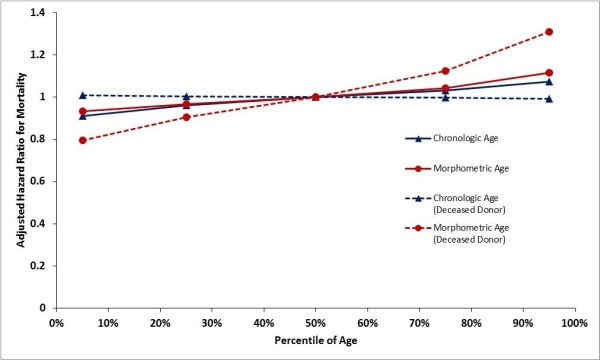Morphometric Age as a Predictor of Survival Following Kidney Transplantation
M. Terjimanian,1 D. Cron,1 D. Cote,2 J. Augustine,2 K. Noon,2 S. Wang,1 M. Englesbe,1 K. Woodside.2
1University of Michigan, Ann Arbor, MI
2Case Western Reserve University, Cleveland, OH.
Meeting: 2015 American Transplant Congress
Abstract number: 387
Keywords: Kidney transplantation, Radiologic assessment, Survival
Session Information
Session Name: Concurrent Session: Kidney: Pregnancy, Metabolic Complications, Malignancy
Session Type: Concurrent Session
Date: Tuesday, May 5, 2015
Session Time: 2:15pm-3:45pm
 Presentation Time: 2:51pm-3:03pm
Presentation Time: 2:51pm-3:03pm
Location: Room 119-B
INTRODUCTION: Better measures of pre-operative risk stratification are needed in kidney transplantation. Analytic morphomics, which utilizes pre-operative imaging, has been shown to objectively assess mortality risk in liver transplantation, but previously has not been surveyed among kidney recipients. We hypothesized that increased morphometric age is associated with decreased survival.
METHODS: Using the baseline morphometric characteristics of aging (trunk muscle size, muscle density, and aortic calcification), morphometric age was determined for 127 kidney transplant recipients. The primary outcome was patient survival. Standard survival analysis using Cox regression performed.
RESULTS: After adjusting for other clinically relevant covariates, morphometric age was a significant predictor of mortality (p=0.012, HR = 1.05 per morphometric year, 95% CI: 1.01 – 1.09), but did not particularly outperform chronologic age (p=0.025, HR=1.07 per year, 95CI: 1.01 – 1.14). However, amongst deceased-donor recipients (N=72), morphometric age remained significant (p=0.02), while chronologic age did not (p=0.76). The adjusted hazard ratio for mortality, normalized to the respective 50th percentile, for each age is shown in the Figure.
CONCLUSION: Morphometric age is significantly associated with survival following kidney transplantation, especially in deceased-donor recipients. Analytic morphomics may have the potential to inform transplant decision-making.

To cite this abstract in AMA style:
Terjimanian M, Cron D, Cote D, Augustine J, Noon K, Wang S, Englesbe M, Woodside K. Morphometric Age as a Predictor of Survival Following Kidney Transplantation [abstract]. Am J Transplant. 2015; 15 (suppl 3). https://atcmeetingabstracts.com/abstract/morphometric-age-as-a-predictor-of-survival-following-kidney-transplantation/. Accessed December 19, 2025.« Back to 2015 American Transplant Congress
